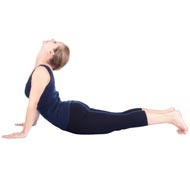- Arm Stretches
- Chest Stretches
- Shoulder Stretches
- Leg Stretches
- Knee Stretches
- Lower Back Stretches
- Hamstring Stretches
- Running Stretches
- Back Stretches
- Thigh Stretches
- Groin Stretches
- Neck Stretches
- Glute Stretches
- Hip Stretches
- Golfers Stretches
- Calf Muscles Stretches
- Ankle Stretches
- Iliotibial Band Stretches
- Piriformis Stretches
- Warm Up Stretches
- Dynamic Warm Up Stretches
- Soleus Stretch
- Gastrocnemius Stretch
- Quadricep Stretches
- Ballistic Stretching
- Adductor Stretch
- Bicep Stretch
- Triceps Stretch
- Spine Stretches
- Upper Back Stretches
- Abdominal Stretches
- Types of Stretching
Lumbar Stretches
Your spine is the control center and source of strength of almost all activities. The spine consists of vertebrae that are connected by tough ligaments and supported by the large paraspinal muscles. All these work in tandem to maintain the correct alignment and positioning of the spine in order for it to function properly.
The paraspinal muscles also support the muscles of the upper body. The lower lumbar region of the spine is the powerhouse of all movements.
Injury to this area can cause innumerable problems in the lower back area and can prevent us from performing many activities. If you suffer from lower back pain, chances are your lumbar muscles and ligaments have been sprained our injured. They could have been overstretched due to exercise and torn or they could become stiff with disuse and a sedentary lifestyle. Either way, lower back pain is one of the most common complaints today.
Common symptoms of a lumbar sprain or strain are spasms of pain felt in the lower back region. This pain occurs when you move about and reduces when you are at rest. There could also be pain around the upper buttocks. An inflammation of the lumbar spine region is what causes this pain. The best way to deal with this is through lumbar stretches. Lumbar stretching exercises help strengthen and stretch the lower back muscles. This can reduce the risk of injury as stretching makes the muscles more flexible. Lower lumbar stretches can also control the inflammation of the muscles and aid recovery. Lower lumbar back pain can be addressed with a few simple stretching exercises such as spine stretches in squat position, overhead squats and the prayer stretch. If regular exercise and stretching do not improve the pain, try yoga for a safer therapeutic alternative.
Yoga lumbar stretches involve gentle poses or asanas that increase the flexibility and strength of the muscles. Lumbar stretches in yoga generally involve stretching and twisting the spine back into shape. Yogic breathing can also increase the flow of blood and oxygen to the affected muscles. This eases stress and tension and flushes out toxins that have collected in the muscles. Yoga poses such as the Mountain pose, the Cobra pose, and the Triangle pose all build strength in the muscles of your lower spine. The Child’s pose is another yoga favorite for spinal pain as it reduces fatigue and stretches the spine to its maximum. If you suffer from lower lumbar pain always inform your yoga instructor before beginning any routine. If these yoga postures are done incorrectly, they can severely aggravate pain symptoms and increase the chance of further injury.
Types Of Lumbar Stretches
Lumbar Extension and Abdominal Stretch
- Lie on your stomach with your legs stretched out behind you.
- Keep your arms to your side and place them on towards your buttocks as you raise your upper body off the floor.
- Hold and lower your upper body slowly back to the ground.
- If you can manage it, you can intensify this stretch by clasping your ankles behind you and bending your body into a U shape as you raise your upper body.
Lumbar Extension Stretch
Another variation of the lumbar extension.
- Here you lie flat on your stomach.
- Place your palms just under your shoulders.
- Keep them close to your body with the palms flat on the ground.
- Push your shoulders upwards till your upper body lifts off the floor.
- Keep your belly button fixed firmly on the ground.
- Feel the stretch on your lower back.
- Hold and release.
Lumbar Flexion Stretch
- Kneel down on the floor. Sit back on your heels.
- Raise your hands above your head and slowly lower your upper body to the floor in front of you.
- Keep stretching your hands in front of you and keep your chin and head towards your chest.
- Try and keep your hips on your heels throughout.
- Slowly return to starting position.
- Perform three sets of 20 reps each.
Lumbar Rotation Stretch
- Lie on your back and bend your knees.
- Keep your shoulders flat on the floor.
- You can stretch your arms out if this feels easier.
- Keep your knees together, twist at your torso and roll your knees to one side.
- You should feel the stretch all along your back and hip.
- Hold for 30 seconds, release and repeat on the other side.
Lumbar Vertebrae Stretch
This is a simple stretch that you can do several times a day.
- Lie on your back. Bend your knees and pull in your stomach muscles tight.
- Your lower back should now be flat against the floor.
- Hold for 30 seconds and releas
Lumbar Stretches: Do's & Don'ts
Always follow lumbar stretches dos and don’ts prescribed by your physiotherapist and trainer. These include
Do's:
- Stopping any exercise if you feel pain and breathing deeply throughout.
Don'ts:
- Never overstretching
Lumbar Stretches Benefits
- Lumbar stretches benefit the lower spine by reducing pain and preventing injury.
- Chronic stress can cause a number of spinal problems and lumbar stretches can lessen the chances of these occurring.
- The stretches also improve mobility and flexibility and increase your range of motion.
- Stiffness is reduced and your posture improves as well but only if you perform the stretches correctly.



